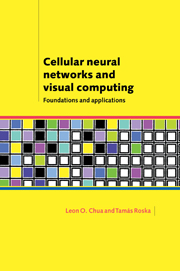Book contents
- Frontmatter
- Contents
- Acknowledgements
- 1 Introduction
- 2 Notation, definitions, and mathematical foundation
- 3 Characteristics and analysis of simple CNN templates
- 4 Simulation of the CNN dynamics
- 5 Binary CNN characterization via Boolean functions
- 6 Uncoupled CNNs: unified theory and applications
- 7 Introduction to the CNN Universal Machine
- 8 Back to basics: Nonlinear dynamics and complete stability
- 9 The CNN Universal Machine (CNN-UM)
- 10 Template design tools
- 11 CNNs for linear image processing
- 12 Coupled CNN with linear synaptic weights
- 13 Uncoupled standard CNNs with nonlinear synaptic weights
- 14 Standard CNNs with delayed synaptic weights and motion analysis
- 15 Visual microprocessors – analog and digital VLSI implementation of the CNN Universal Machine
- 16 CNN models in the visual pathway and the “Bionic Eye”
- Notes
- Bibliography
- Exercises
- Appendices
- Index
16 - CNN models in the visual pathway and the “Bionic Eye”
Published online by Cambridge University Press: 28 May 2010
- Frontmatter
- Contents
- Acknowledgements
- 1 Introduction
- 2 Notation, definitions, and mathematical foundation
- 3 Characteristics and analysis of simple CNN templates
- 4 Simulation of the CNN dynamics
- 5 Binary CNN characterization via Boolean functions
- 6 Uncoupled CNNs: unified theory and applications
- 7 Introduction to the CNN Universal Machine
- 8 Back to basics: Nonlinear dynamics and complete stability
- 9 The CNN Universal Machine (CNN-UM)
- 10 Template design tools
- 11 CNNs for linear image processing
- 12 Coupled CNN with linear synaptic weights
- 13 Uncoupled standard CNNs with nonlinear synaptic weights
- 14 Standard CNNs with delayed synaptic weights and motion analysis
- 15 Visual microprocessors – analog and digital VLSI implementation of the CNN Universal Machine
- 16 CNN models in the visual pathway and the “Bionic Eye”
- Notes
- Bibliography
- Exercises
- Appendices
- Index
Summary
There is an on-going quest by engineers and specialists: compete with and imitate nature, especially some “smart” animals. Vision is one particular area computer engineers are interested in. Terms like “machine vision” and “computer vision” demonstrate this interest. Recently, modeling the living visual system has become a focus in science and technology. As the anatomy and physiology of the eye and other elements of the visual pathway are becoming more and more known, especially in the retinatopic part (Retina, Lateral Geniculate Nucleus (LGN), and the Visual Cortex), engineers have been trying to imitate these models. These studies have led to a better understanding of vision, overcoming the clear deficiencies of earlier, though useful, principles of computer vision before the mid 1980s.
Based on the ground-breaking studies of Barlow, Dowling, and Werblin on vertebrate retinas, a very simple model of the retina, a resistive grid, was implemented on silicon and demonstrated by simulation studies. In spite of the many “silicon retinas” built on this simple resistive grid model, it became clear that these models are too simple to explain even some practical qualitative effects related to higher-order spatio-temporal interactions in the retina. Attempts to address the more sophisticated retinal models led to descriptive and network type models. In the latter case, not only the retina, but a lot of other parts in the visual pathway had been first modeled by using a single paradigm: cellular neural networks.
Information
- Type
- Chapter
- Information
- Cellular Neural Networks and Visual ComputingFoundations and Applications, pp. 320 - 338Publisher: Cambridge University PressPrint publication year: 2002
